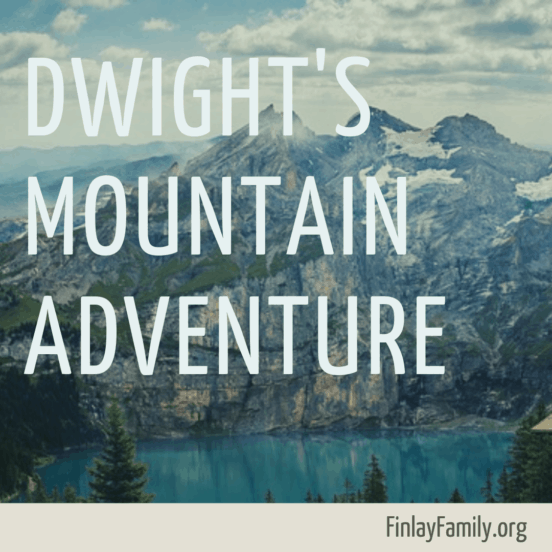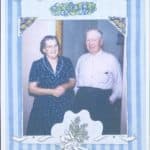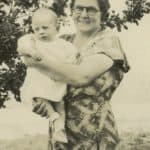Dwight Farnworth had a magical way with words. He memorized and wrote poetry, wrote his life history and also kept a detailed, descriptive journal of his life. Here is a beautifully written excerpt from his journal of family summer camp 1972 and one of the adventures he spontaneously went on with a friend:

“On August second John Swank came in his
“We drove north on the highway about four miles. A couple of blocks after we passed the sign pointing to Boulder Mountain, we took a dirt road to the right. You could see the mountains so high and majestic. I thought we would go just a little way to the bottom of them and then come back. Nay-not-so. It took us six hours of the hardest driving I have ever seen to reach the top and come back down.
“We passed a woman painting the mountains as we turned off the highway. Shortly thereafter, John stopped and put the links in the front wheels to make it four wheel drive. Within half mile of the highway, we had to cross the stream on a rickety old bridge that would have stopped my car. We took it in stride. There were grove after grove of quaking aspen that covered the foothills. The road followed the stream, that was rollicking down from the mountain. We followed it around the edge of a round foothill until we hit the pines. As we hit the pines we came upon a beautiful little cove. Years before someone had built a log cabin there. What a beautiful site for one. It was quite level for the space of about four acres and had a good view of the valley through the trees which were spaced here and there all over the level area. There was a spaciousness about the place rather nostalgic and lovely. The cabin had fallen in decay and was just a pile of logs tumbled into a semblance of a square.

“The road went off to the left of the cabin and began its torturous climb. Sometime it was so narrow that the trees on either side reached out to touch the sides of the pickup. Sometimes the road was the bed of the creek as it wound its way through the giant rocks, stumps, trees and hills. At times the road would be quite above the stream and you could look into shady nooks and moss covered areas with tiny or large waterfalls shimmering in the patches of shade and light.
“We passed a giant sluice box, or so we called it. It had a road, old and unused for years, going right to the top of it. They must have dumped the ore in this giant box to store until the wagons came to haul it away. The box pushed the road over to the other side, it stood so close. There were three shoots with sliding gates, that when pulled, the ore would fall unto the waiting wagons.
“We wound on past. Coming next to a well preserved log house. It was well made. The logs were sawed square all around. The ends of the logs had been mitered so as to lock each other at the corners. The front windows were boarded but the door was gone and the back window also. When we stopped and entered it, we found they had used it as a barn in recent times. The floor was laid on the ground with a subfloor and a layer of boards over that. There was a stairway of two by tens with two by tens notched in to make the stair treads. The upper floor was shakey but substantial. They had two holes for chimneys. The logs they used for ceiling joists were square with a square notch in the wall logs to hold them in. The roof was corrugated steel in a good state of preservation. We remarked that it would take very little work to make the cabin liveable. The trash dump was a few steps from the back door and contained all the relics of living. Rusty cans, tobacco cans and old shoes, so badly decayed and twisted but still showing the form of the old style. The dump, as were all the dumps we saw, were dug up and sifted through by diggers of treasure relics.
“We next came upon a giant of a log structure. The logs were three feet by four feet and it was a good fifty feet square. It had a second floor with the ground floor being a stable or barn. The stalls were formed by a log on the floor and chiselled into the log, as it were, were post holes. The holes were narrow in width and long in the length. They had cut logs into semi-boards with an axe and had driven them into the holes. These upright boards were close enough together to form the walls of the stalls. The roof had fallen in as had part of the upper floor. We walked to the back of the structure and found the back door entered into the top floor as it was built on the side of a mountain. There was quite a fump to the side of this indicating that the upper story had been used as a dwelling with the animals below supplying their heat.
“The road became more rough and steep from here on. Large boulders as big as a person’s head were oftentimes the gravel we drove over. We came upon a place where the road went right up the stream bed for a quarter of a mile. The flowers were beautiful. There was a fellow there with two cameras, each with giant lenses, taking pictures of them.

“The mountains stood high above us like mighty sentinels. Just great rocks, stood on end, that reached up into the clouds. The tops were jagged and sharp, the bodies huge, the bottom was filled with a conglomerate of boulders that had broken off and filled the sloping base. Some boulders as large as a house had rolled down the mountainside and lay in the middle of the valley. The road and stream had to wind their way through them.
“Now the road went almost straight up. It left the stream way below. John stopped the truck so we could take a picture of the road which was so steep I could stand on it only by bracing myself against the truck. There were head sized boulders on the road and the water of a hidden spring flowed over it. In a very low gear, with all four wheels grasping for footing, we went up, inch by inch.
“At the top, where the pines were scrags and scrubby, there was a beautiful little waterfall. The forests down below were like a green, ordered, overturned pin cushion.
“We came upon an emerald, alpine meadow. The stream was flowing through it in a lazy sort of way. The grass, so green and all around it were beautiful pines. The road
“On the far side of the meadow the road started up again. It rose so rapidly over the molded rock. Giant trees had grown old and fallen with large rocks clasp in their roots. We came to a place where we could look down into the valley. There the road turned so sharply we had to stop, back up, and go ahead again to get around it.
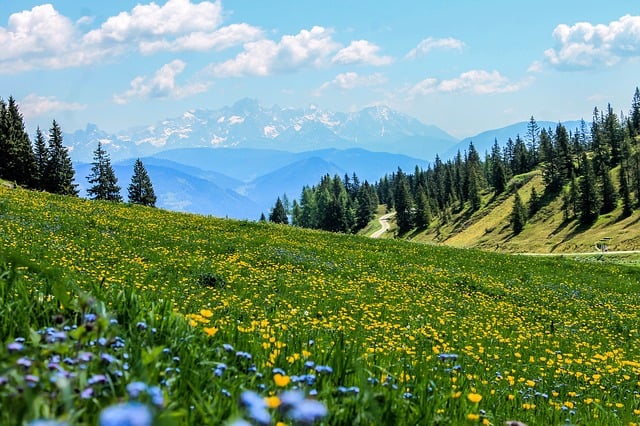
“We entered and passed two more alpine meadows before we came to an impossible part of the road. It led out of a meadow and up over an out cropping of a giant black rock. At the top of the rock we stopped for there the road split and went two ways. One led over the shale of the mountain to the right. It was so narrow and poor for a road that as we were coming back down the other road later, John said: “We didn’t go up that, did we?” He repeated it several times. On top of the rock two tiny railroad irons reached out into the road. They came up from a hole dug right down into the mountain. You could see way down into the slanting hold but although we were tempted, we didn’t go in. The irons had been used for some kind of cart that had to be wenched from the hole. The top, sides and bottom were solid rock. I wondered how they dug it.
“As we were looking at the hole, John looked up the road to the right, and high above us and across the void, was a bull elk and a cow. We watched them as he fed stopping only now and then to watch us. She went up through the giant, dead trees, over an outcropping of rock, down a hogback and out of sight. After a while, the bull followed and we caught a glimpse of him as he walked, stopped, then walked on out of sight.
“Back into the truck and we started on the road to our right. The rocks moved and scudded as we went over them. Some seemed to sink and roll. The four wheels tugged, pushed, and pulled their way along. Once we slid down but another wheel pulled us up and kept us on the road. We came to a large rock that had slid down and lodged in the hillside next to the road. We went out around it. On the way back John said it was much more frightening when you were on the outside. The map said the driver should be an experienced mountain driver. I kidded John, asking him if he really was one. (He was excellent. I was frightened only half the time, up and back, but I never screamed!)
“We drove through the grove of dead giants where stood the elk, then topped a rise and came into a perfect gem of a valley. It was about three miles in diameter and almost a circle. It was far from level. Many small lakes at different levels were contained in it. The mountains looked like some giant had taken gigantic rocks, big at the base and jagged, almost razor sharp at the top, and set them in a circle around the valley. We drove past a decaying log cabin that had been built in the grass close by a crystal, clear lake, then up a hill so steep that the motor died. We had to back down for another try. On the second try we made it up to a shelf, then on up to the crest in the middle of the valley mountain.
“We stopped in a saddle with a solid rock to the left, which we climbed. This had broken up on the other side and there was a glorious, little stream shimmering in the sunlight with a great pile of rocks and shale on the other side. Looking way below, I could see the alpine valley trailing off into the distance, with lakes set like jewels in its bosom.
“As we descended the rock on which we stood, by our various, newly found routes. We jumped from rock to rock, or climbed, slid, scrambled, or dropped down the larger ones. The rocks were all different colors. We found many rocks with minerals fastened to or streaked within them. We looked and hunted through these rocks like kids looking for money in the sand. Each made a little pile of his finds.
“We then went on to the stream. It splashed and eddied over the multicolored rocks that formed its bed. The bank was a pillow of spongy moss and grass that sand as I stepped on it and felt like a giant carpet. There were boulders in the stream, each covered with various colors of moss. Some of the moss was a bright green like emeralds, and others as red as rubies. As I looked at the stream, I noticed the perspective of it all. Close under my feet was the stream with its multicolored mosses, the rocks on the other side, then, as it were but a short distance away the ground stopped and the green floor of the valley, far below, looked as though it was just a few feet away.
“As we came back down the slide road to the mine, we took the other road. From the hill, high up where were the elk, looking across, we could see the road going down the slide and up the other fork to a beautiful little lake. There was a cabin beside it that looked fully intact.
“As we went up the other road, we topped a rise and went through the pines coming upon the lake. On the shore was a tumbled down log cabin. It was quite large. The roof had fallen in as was the upper floor. We wondered how they could live in it as the ceiling of the ground floor was so low. Down the hill a little way from the cabin was logs, two or three deep, lying in a square. John said it must have been a forge.
“We knew the other cabin to be somewhere near. We walked to the shore of the lake and started to look.
“We climbed a big mound of rocks with trees and shrubs growing from it. As we neared the top, we saw the top of the cabin about a block away. It was an oval lake, pinched at the lower end by the rock hill. The cabin was nestled at the lower end of the lake. A stream and tiny waterfall led the water from the lake to a small pool below. The pool was surrounded by grass, then trees, and was a most picturesque view for the cabin.
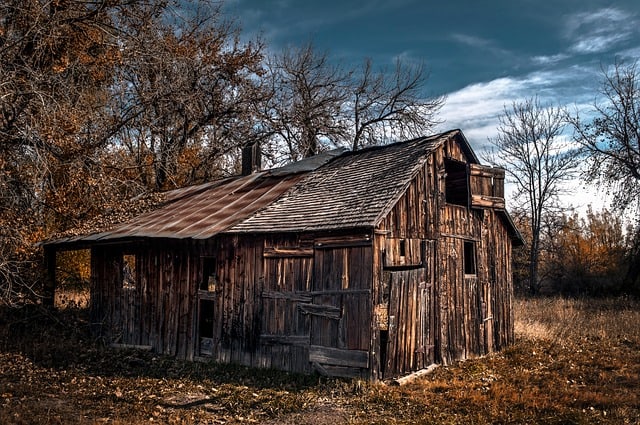
“The cabin was in fair shape. Small but not tiny. It, like most of the cabins we had seen, had an upper floor. I climbed the stairs and saw nothing but what time and the forest had deposited there.
“As we started to leave, we noticed that all the nails used in the cabin were the old fashioned square ones. This was too interesting to pass. Some we pulled from boards that were lying about.
“I was puzzled. How did those rugged people live, so far from everything and so high on the mountain. I looked with awe at all the work they expended to make their wonderful homes.
“I seldom remember seeing such beauty, ruggedness, and breath taking loveliness.
“It was like a dream as we reached home and I thought back on our experiences of the day.”
From “Our Summer in Sawtooth Camp Twelve Miles North of Sun Valley, May 18-August 15, 1972” by Dwight P. Farnworth, page S7-S11.
Dwight Percy Farnworth was born 15 July 1924, in Nampa, Canyon, Idaho, to Percy Q and Nora Edith (Presnell) Farnworth. Dwight was my maternal grandfather.

I hope you enjoyed that bit of family history as I did. See you again soon with another story from the past.
Melissa
